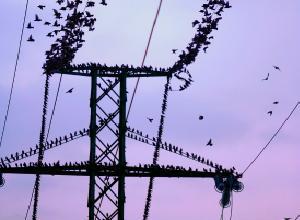| Complexity level: | 6 |
| Project cost ($): | 5 |
| Time required: | It will take an hour to set up the experiment, and 2 days for observation. |
| Material availability: | Look for cable lines that birds often perch on |
| Safety concerns: | None |
Hypothesis
The crow, being a larger bird, will put a greater distance between itself and another crow when perching on a wire. The sparrow, being a smaller bird, will put a smaller distance between itself and another sparrow when perching on a wire.
Overview
Perching birds
A perching bird is known as a passerine or a song bird. More than 50% of birds are perching birds. Common species of perching birds include the sparrow, the pigeon, the crow and the swallow. These birds sit on power cables, tree branches, lamp posts and fences and. They often sing from their perched positions. Birds tend to take this position when perching: their claws will have 3 forward-pointing and 1 backward pointed "fingers" to grip on to the perch.
Crows
Crows are large passerine birds that have a wingspan of between 40cm to 50cm. Normally, crows feed on dead animals and grain. Like parrots, they can imitate human voices. They can also recognize human faces. Crows make a variety of calls or sounds. The type of call crows make depends on their species, and the region and surroundings in which they reside. Crows often cry loudly when they are hungry or when they wish to differentiate their territory from others.
Sparrows
Sparrows are small passerine bids that have a wing span of between 22cm and 25cm. They have brown feathers, a short tail and a strong beak. They are one of the most common wild birds. Sparrows can be found in the city. They may even nest in houses and buildings. Sparrows usually eat seeds and small insects.
Scientific Terms
Materials
The materials required for the experiment are as follows:
- a long ruler (transparent)
- a roll of duct tape
- a measuring tape
- an overhead power cable line or telephone line on which birds can perch
- a calculator
- 2 sticks
Procedure
1. For this experiment, the independent variable is the species of the birds that perch on a selected overhead power cable line (look for crows and sparrows in particular). The dependent variable is length of the distance between the birds when they sit on the cable. Position a ruler at a particular distance from the poles and calculate the length of the distance between the birds using ratios. The constants (control variables) are the distance between the ruler and the cable, the distance between the poles and the types of birds observed.

2. Look for overhead power cables or telephone cables that crows and sparrows often perch on. Using 2 sticks and duct tape, mount the ruler horizontally, some distance from the cable poles. When viewed from a selected position through the ruler, the two poles should be seen between the 2 sticks.
3. Measure the distance between the 2 poles using a measuring tape. Also measure the relative distance between the 2 poles, with the help of the ruler. The length ratio is to be the actual distance between the poles divided by the measured distance between the poles as recorded on the ruler.
4. When the crows or sparrows are sitting on the cable, measure the distance between them as through the ruler. Multiply this by the length ratio to obtain the actual distance between the birds. Do this with 5 pairs of birds of each species and record the readings in the table below.


Results
The crow puts a greater distance between itself and another crow when perching on a wire. The sparrow puts a smaller distance between itself and another sparrow when perching on a wire:
| Bird | Distance between perching birds (millimeters) | ||||
| Pair 1 | Pair 2 | Pair 3 | Pair 4 | Pair 5 | |
| Crow | 233 | 241 | 226 | 239 | 230 |
| Sparrow | 124 | 132 | 118 | 128 | 120 |
Our results are plotted on the graph below.

Conclusion
The hypothesis holds true: the crow puts a greater distance between itself and another crow when it perches on a wire. The sparrow puts a smaller distance between itself and another sparrow when perching on a wire.
Birds that sit on a power cables or telephone lines usually sit at equally spaced distances between one another. It is almost as if the birds have a way of measuring the distance between their perching neighbor. This gap is commonly referred to as the "individual distance" and it is a characteristic displayed by a few species of birds. It arises due to the territorial nature of the bird species.
Also consider
Conduct the experiment under different weather conditions (a sunny, cloudy, windy or rainy days).
Identify a different species of bird for the experiment (eg. pigeons). How does their behavior compare with that of the birds in this experiment?
References
What determines individual distance? - http://birdcentral.net/distance.htm
Sparrow - http://en.wikipedia.org/wiki/Sparrow
Crow - http://en.wikipedia.org/wiki/Crow
Passerine - http://en.wikipedia.org/wiki/Passerine

